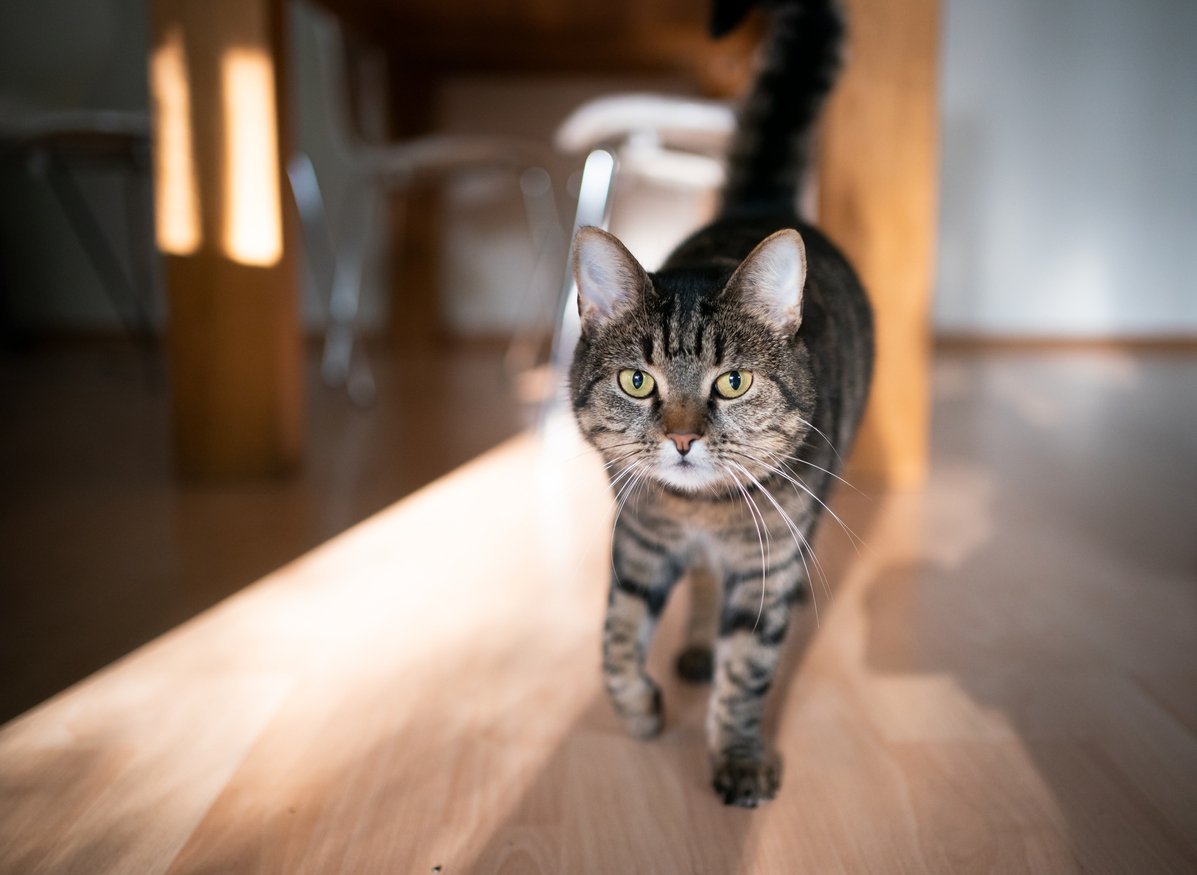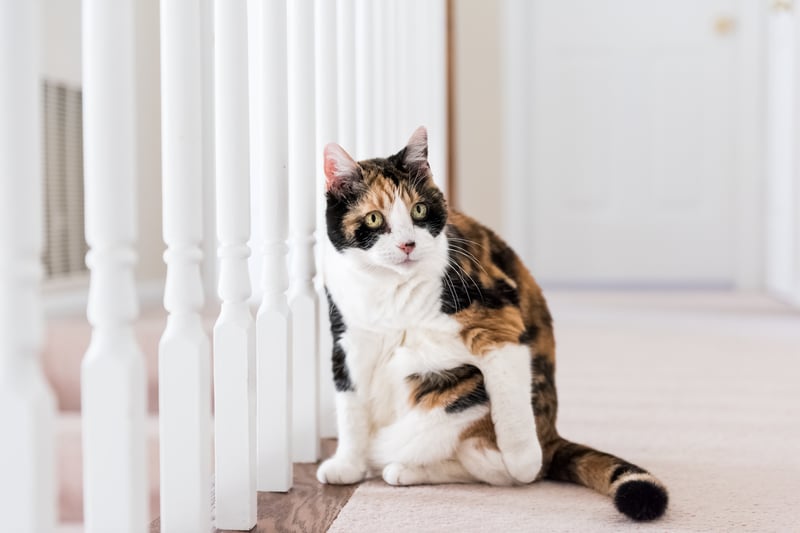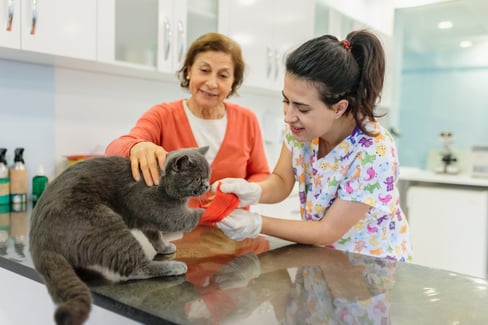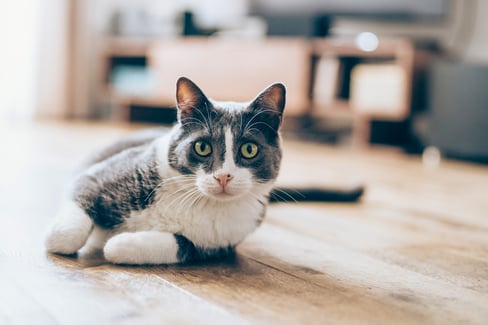Table of Contents
Humans have adored and spoiled pet cats for thousands of years. Egyptians worshipped their cats and are thought to be the first to domesticate them.
French archaeologists found a human's and a cat's remains buried in the same site on the Mediterranean island of Cyprus. The remains of the companions are estimated to be about 9,500 years old!
In many ways, we have evolved, but the human-cat connection hasn't changed. We still have our cats by our sides and love them for the independent creatures that they are.
Cats are willing and capable of caring for themselves, and it shows. Cats rarely give, even the most doting pet owner, any inclination that they are experiencing pain. So if your cat is exhibiting obvious signs that they are suffering, you rightfully get worried and will go to any measure to avoid unnecessary distress.
Since cats hardly ever make their discomfort known, if a cat is limping, it's obvious that something is wrong. Reasons for a cat limp can range significantly in severity, but they are all cause for concern when you are a loving cat owner with only the best intentions for your pet.
Limping Cat Symptoms
There are several plausible reasons why your cat is limping. From a thorn in their paw to a degenerative condition to broken bones, some conditions are easier to diagnose than others.
Depending on the cause, your cat may display one or more limping cat symptoms:
- Running and walking slower or abnormally
- Showing apprehension or avoiding making leaps, jumps, and landings that they used to nail like a pro
- Grooming inconsistency
- Obsessive licking of a specific area
- Not placing weight on the affected area or holding the paw off of the floor
- Loss of muscle around the affected area
- Swelling around the joints
- Irritability
“What if my cat is limping but still jumping and running, or my cat is limping but acting normal?”
Not every cause of a limping cat will have other symptoms. Remember, cats are far more resilient and far less likely to show signs of pain than us humans.
Why Is My Cat Limping?
We’ll go through these in-depth below, but some of the common causes for limping in cats include:
- Foreign object in the paw
- Injuries
- Infection
- Genetic diseases
- Feline arthritis
- Immune diseases
1. Foreign Object in the Paw
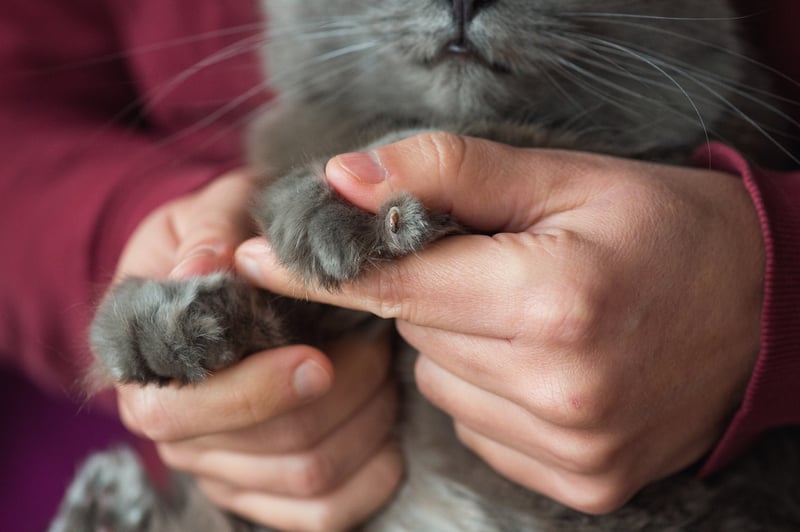
Outdoor cats can get into some mischief. Cat owners are all too familiar with their feline coming home from a "night out" with burrs in their fur, leaves affixed to their bellies, and thorns, pine needles, or random pieces of brush caught in their paw pads.
You may notice signs of something foreign in the paw if your cat is:
- limping
- holding one foot off of the ground
- obsessively licking one paw
Prevention
Cats are adventurous creatures. If you let your cat go outside, you can't exactly tell them not to get dirty or acquire the occasional thorn in the paw. These things come with being an outdoorsy thrill seeker. So what to do if your cat is limping?
Treatment
Hopefully, most of these cases are simply remedied at home without needing help from the veterinarian. Pulling a little stick or pine needle out of your cat's paw is one thing, but vet intervention is necessary if your cat's injury seems serious or you have a cat limping and lethargic.
If your cat is losing blood from stepping or falling on something more dangerous, call the vet or emergency and have them deal with it immediately. In severe cases, as with our serious wounds, removing the object that has penetrated the skin can cause more damage than good if done incorrectly.
2. Injuries
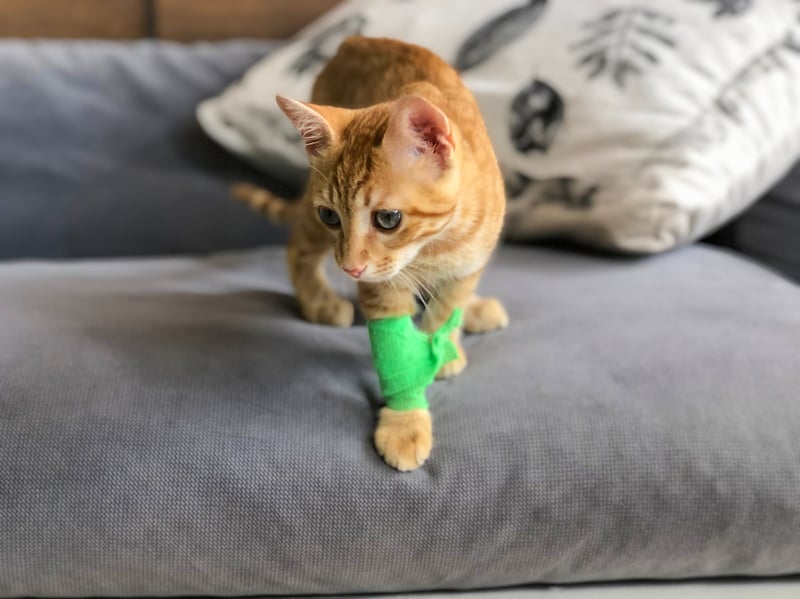
Obviously, injuries can cause limping in cats. They may have forgotten they don't have wings and landed funny when they jumped from the top of the refrigerator to the floor again.
When cats tend to jump from extremely high places, it is referred to as high-rise syndrome. This syndrome is less about cats making poor decisions and more about cat parents assuming responsibility for their cats' well-being and safety.
We know cats don't feel the same about heights as we do. Cats show no fear regarding 2, 3 or even 20-story open windows. Just because your cat acts invincible doesn't mean they are. Of course, high-rise syndrome can cause any of the following injuries:
- Broken bones
- Dislocation
- Sprains & strains
Broken bones
The most serious and frightening injury for a pet owner or parent of any species is a broken bone. Your cat will probably handle the pain like a champ but don't let them fool you, it hurts them as much as it would anyone else.
Signs of a broken bone:
- Severe limp from a fracture
- Avoiding putting any weight on the affected leg
| Broken Bone Dos and Don’ts! |
|
| Be incredibly gentle & take your time scooping up the injured animal. |
Don’t try to reset the bone yourself |
| Use a soft familiar blanket or towel to pick up skittish cats who may otherwise harm themselves, avoiding being handled. |
Don’t touch the affected area unless absolutely necessary |
| Contact the vet and get there ASAP |
Don’t allow the broken leg to hang or swing |
Dislocation
When ligaments and tendons become damaged because of a prior injury like a broken bone, sprain, or strain, the damage can cause laxity or "loose ligaments". Laxity allows for joints to pop in and out of place often, which causes limping in cats. The consistent rubbing of bone to bone and degeneration of cartilage in the joint can lead to swollen and painful joints or osteoarthritis in cats.
Underlying conditions that can cause dislocations:
- A hip dislocation often happens in animals with hip dysplasia, a hereditary disease in cats, dogs, and humans where the hip joint ball and socket are misaligned and "loose" due to the ligaments and tendons stretching out around the joint.
- The sliding kneecap or a luxating patella occurs when the groove that contains the kneecap is too shallow. The kneecap then slides in and out of the socket.
- Tail dislocation most likely comes from trauma to the tail, such as being accidentally shut in a door or window.
Sprains and strains
Sprains & strains are bound to happen to cats with active lifestyles. A cat sprained leg stretches out the ligaments that connect the bones, while a strain occurs when the tendons overextend. Both can be painful, impede movement, and result in limping in cats. Sprains and strains can lead to Arthritis as cats get older.
Sprains & strains are caused by:
- Jumping
- Falling
- Slipping
Prevention
Whether your house or apartment has more than one story or you just want to make the place as safe as possible for your limping cat, these things can help curb the possibility of injury:
- Keep your windows closed and get an air conditioner for the stifling months
- Installation of cat hammocks or beds that mount onto window sills is readily available.
- If you allow your cat to sit by an open window on any floor, with or without a cat hammock, make sure screens are strong, sturdy, and securely affixed to the window.
- If your cat didn’t start as an outdoor cat, keep it that way.
Treatment
Injury treatment will depend on the type and severity of the injury. Broken bones will need to be set back in place by a licensed veterinarian and splinted. Healing time for broken bones in cats ranges from six to eight weeks.
For other, less serious injuries like sprains, strains, and dislocations, NSAIDs or nonsteroidal anti-inflammatory drugs, supplements, healthy nourishment, and some good old rest and relaxation is the ticket to your cat’s recovery.
3. Infection
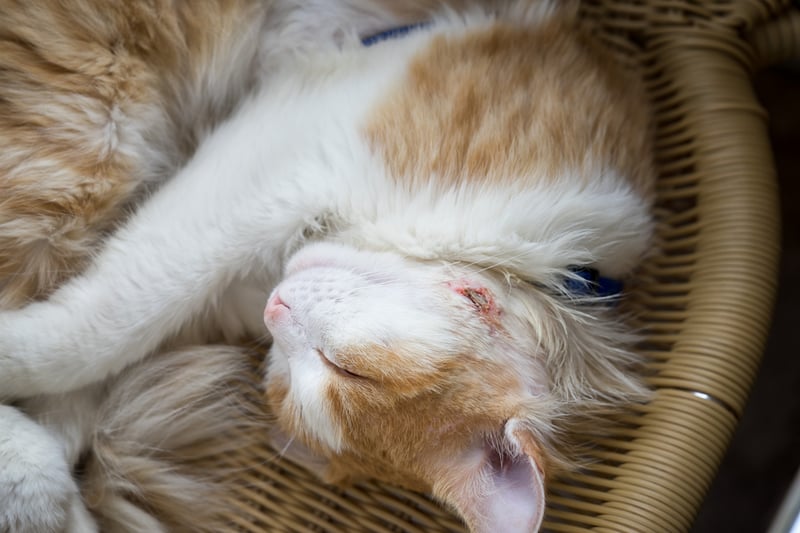
Infection can occur in the joint after an injury or surgery to the joint. Septic arthritis is an infection that can arise in cats, though it is rare and more common in dogs.
Septic arthritis happens when an infectious agent or bacteria is introduced to the joint. This infection causes swollen and painful joints where affected.
Symptoms of septic arthritis:
- Fever
- Lethargy
- Warm, swollen, and sore joints
- Lack of appetite
- Reluctance of movement
Prevention
To prevent infection to joints and other parts of the body:
- Provide proper aftercare for an injured cat or recovering cat.
- Go to your follow-up appointments after a cat's surgery or injury.
- Stay aware of your cat's actions and report symptoms to the vet as soon as possible.
- The best prevention is aiding in the retention of healthy joints and cartilage.
Treatment
Cats with severe infections may need:
- Hospitalization allows for the administration of intravenous fluids, antibiotics to treat the infection, and consistent monitoring.
- Surgery and removal of the affected joint may be necessary to remove the infection.
- Flushing of the joint with a solution to clear the infection.
A veterinarian needs to clear all exercises after any treatment for infection to ensure that illness and pain don't resume.
4. Genetic Diseases
Some common genetic diseases in cats include:
- Hip dysplasia
- Musculoskeletal disorders
- Myopathies
Hip dysplasia
Hip dysplasia is a hereditary disease where the ball and socket of the hip joint are misaligned, causing laxity in the ligaments and preventing smooth movement. Persistent dislocation of the hip joint causes pain and swelling.
Some breeds are more likely to be troubled by hip dysplasia than others. 20% of long-haired cats are afflicted by hip dysplasia, while only 5% of shorthair breeds are affected!
What breeds are at the highest risk for hip dysplasia in cats?
- Mainecoon cats
- Persians
- Himalayan
Prevention
Hip dysplasia will inevitably manifest in some cats, but there are certain things you can do to keep things lubricated and moving more smoothly:
- Joint and mobility supplements to help keep healthy tissue and repair damaged tissue
- Omega-3s to aid in lubrication and healing
- Avoidance of twisting and tweaking the hip joint.
TRI-ACTA for Pets
A proactive approach for developing and younger adult pets to maintain optimal joint health mobility, minimize inflammation and fend off age-related ailments.
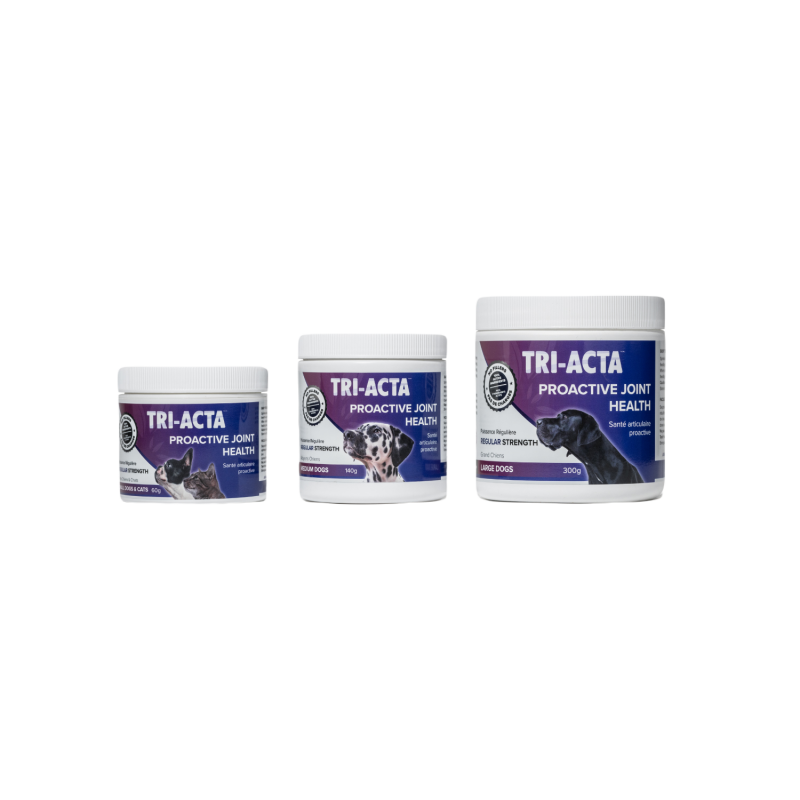
Treatment
In most cases, cats respond well to non-surgical solutions.
Hip dysplasia can be treated in one of two ways:
- Non-surgical treatments
- Surgery
Non-surgical treatments
In most cases, cats respond well to non-surgical options like:
- Medical management
- Physical Therapy
- Weight loss
- Pet supplements
Medical Management
NSAIDs or nonsteroidal anti-inflammatory drugs can be very helpful in managing symptoms of degenerative joint disease and limping in cats.
Supplements like glucosamine and chondroitin cocktails, and Omega-3s can offer relief as well as probable regeneration of tissues and cartilage.
Physical Therapy
I know what you're thinking, "how is my cat going to sit through someone manipulating their extremities?" Particular cats might not stand for it, but remember, these are trained professionals with years of schooling and knowledge to back up their practice. Physical therapy could be worth a shot.
Weight Loss
We all love to indulge our pet cats with their favourite treats, but spoiling them too much is bad for their health as obesity increases the risk of hip dysplasia. You can manage your cat’s weight and encourage weight loss by swapping treats for toys and asking your vet for a safe and effective weight-loss program.
Pet Supplements
Supplements like glucosamine and chondroitin cocktails, and Omega-3s can offer relief as well as probable regeneration of tissues and cartilage.
The best combination of ingredients to look for in cat joint supplements are:
- Glucosamine
- Chondroitin
- MSM
- Hyaluronic acid
TRI-ACTA H.A. for Pets contains a potent blend of all the ingredients mentioned above in a dry powder form with active ingredients and no fillers.
TRI-ACTA H.A. for Pets
Our maximum strength formula is optimally designed to accelerate the formation of cartilage, minimize inflammation, expedite the healing process, and improve joint conditions.

Surgery
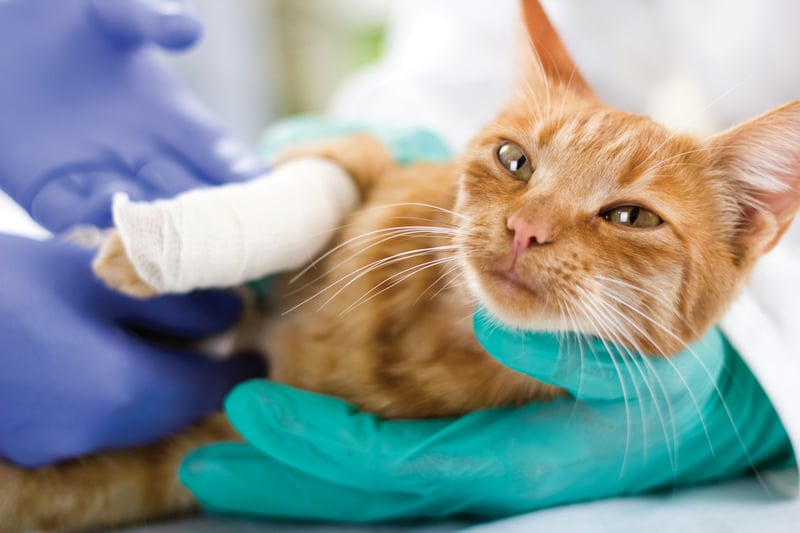
Surgeries for hip dysplasia in cats are few but largely successful if necessary. They can vary depending on the cat's age and activity level.
Two types of surgical procedures are available to cats with hip dysplasia:
- The femoral head and neck ostectomy—The ball and neck are removed from the remainder of the femur in hopes that the body will grow another hip joint.
- Complete hip replacement—The ball and socket are eradicated and replaced with a new synthetic hip joint.
But there are also other conditions that may require surgery:
- Musculoskeletal disorders—that extra toe that you think is so cute is actually a musculoskeletal disorder that has been passed down through generations. Extra digits on the paws can cause a misaligned gait which can cause damage to the joint over time.
- Myopathies—generally affect the voluntary control of muscles in the body. Myopathies cause extreme muscle weakness and can be a reason for cat limping in some instances.
Treatment
Is surgery necessary for treatment? Definitely not! Some diseases are not preventable and will need surgery or other more extreme care. In cases of hip dysplasia, there may be no other option but a full hip replacement if the damage is too severe.
However, in many cases, non-surgical treatment has been very successful in cats, with the use of NSAIDs (nonsteroidal anti-inflammatory drugs), cat supplements, physical therapy, and weight management.
5. Feline Arthritis
Arthritis or degenerative joint disease causes swelling in the joints due to the degradation of the cartilage.
There are two types of feline arthritis:
- Rheumatoid Arthritis - a condition that causes the immune system to attack healthy joints. Luckily, this is less common in cats.
- Osteoarthritis - also known as “feline degenerative joint disease” is a condition caused by various things. From past injuries to hip dysplasia, osteoarthritis is widespread where cartilage is damaged, and bone grows around the joint. Without cartilage to cushion and protect joints, bone rubs against bone, making for stiff joints and painful inflammation.
60% - 90% of all cats will develop a feline degenerative joint disease within their lifetime.
But what exactly causes arthritis?:
- Genetics
- Trauma or injury
- Obesity
- Age
Genetics
Certain breeds of cats may be more likely to develop osteoarthritis than others. Cats with hereditary conditions like hip dysplasia are very likely to develop arthritis later in life due to consistent bone-to-bone contact, recurrent dislocation of the hip joint, and degeneration of cartilage.
Trauma or injury
Injuries can cause damage to the joints, tendons, muscle tissues, and ligaments. This damage, along with natural degeneration, is a common cause of arthritis and limping in cats.
Prevention
Cats are virile and bold animals; they will take some risks. Could you do your best to keep an eye on them? Please take into account what risky behaviours your cat does most often and start safeguarding against them.
Treatment
Notice risky behaviours and find ways to accommodate risky behaviours if possible, safely.
| Risky Cat Behaviour |
What You Can Do |
| Sitting in high window sills |
|
| Jumping from high furniture and appliances |
|
| Hyperactivity due to boredom |
|
Obesity
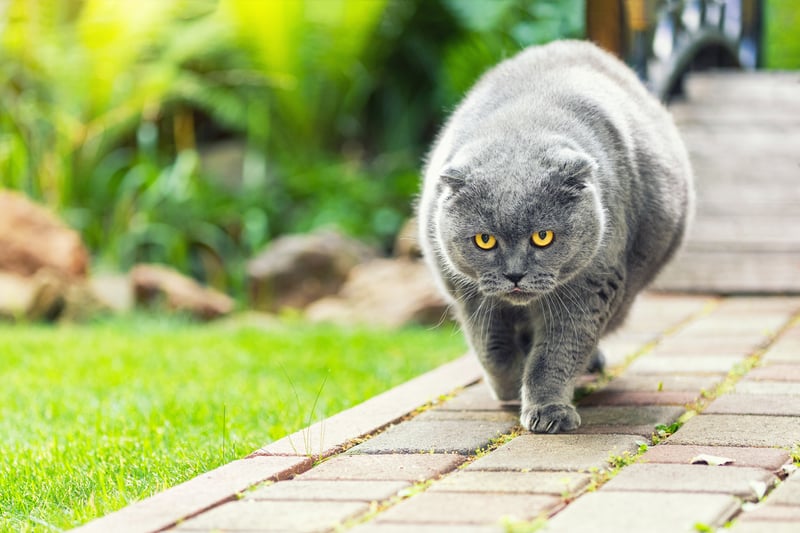
You don't have to be a rocket scientist to know that the more weight you put on your joints, the more likely damage will result. Preventative measures are the best option.
Prevention
Some cats are capable of being "free eaters". Cat owners can leave food out for these types and trust that they will not engorge themselves to the point of over-eating.
Other cats, particularly feral or stray cats turned house cats, may benefit from more strict guidelines to maintain a healthy weight. Feral and former stray cats may be overeating because of past emotional trauma and fear of starvation. We all know old habits die hard!
Treatment
Choose quality, nutritious foods along with setting a consistent feeding schedule for your cat. Be sure to feed your cat enough; cats don't do crash diets like humans. Use the serving sizes advised based on your cat's body weight.
Age
As mammals age, degeneration occurs in the muscles, cartilage, ligaments, tendons, etc. Age is the most common reason for Arthritis. Cats may start to experience signs of Arthritis around seven years old.
Prevention
No matter how much we would like to keep our cats young forever, it just isn't in the cards. However, preventative measures can be taken to prolong and stimulate the growth of healthy cartilage, like:
- Supplements
- Omega-3s
- Healthy nutrition
6. Immune diseases
Immune diseases that may be included are:
- Bone cancer
- Feline Calicivirus
Bone cancer
Osteosarcoma or bone cancer accounts for 95% of all bone tumours.
Types of Osteosarcoma are:
- Chondrosarcoma - in cartilage cells
- Fibrosarcoma - in soft tissues or skin
- Hemangiosarcoma - in blood vessels
What are the signs of bone cancer in cats?:
- Swelling or a mass
- Loss of appetite or difficulty eating
- Limping and lameness
- Breathing difficulties
- Lethargy
- Neurological symptoms like seizures or a wobbly walk.
Prevention
Proactive is more of the name of the game in this case. Like humans, the sooner you can diagnose osteosarcoma, the better chance of fighting it off.
Treatment
There are several treatment options for a cat with bone cancer.
- Chemotherapy
- Radiation
- Amputation of the affected limb, or you can opt for
- Limb-sparing surgery—affected bone is removed and replaced with a bone from either your pet or a bone bank.
Feline Calicivirus
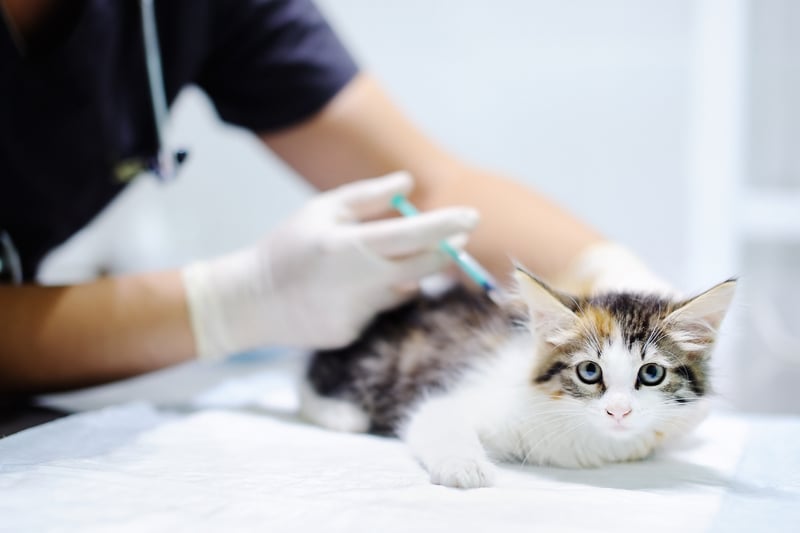
Feline calicivirus is the leading cause of cat flu or feline upper respiratory tract disease and can also cause limping.
Signs of FCV:
- runny nose and eyes
- conjunctivitis
- fever
- oral ulcers
- lameness
Studies have shown that calicivirus can affect the membrane surrounding the joints. In some cases of FCV, the virus can be completely isolated to the joints, causing lameness varying from a confined area to some cats showing unwillingness to move at all.
Lameness in cats is reported so often in correlation with feline calicivirus that the condition has been named "limping syndrome". Lameness and limping are associated with pyrexia or a high body temperature. Stiffness and pain usually subside two to three days after the virus has run its course.
Prevention
Feline calicivirus is most likely to be seen in kittens between 8 and 12 weeks old. Like the human influenza vaccine, the calicivirus vaccine can induce some known symptoms, particularly in kittens.
FCV can cause the swelling of more than one joint. This condition is referred to as polyarthritis.
Treatment
Cats usually recover from the flu caused by feline calicivirus relatively quickly without much medical management or intervention. However, your veterinarian can prescribe anti-inflammatories or antibiotics if signs are severe.
What to Do if My Cat is Limping?
Depending on the cause of your limping cat, treatment plans and procedures will differ. If you notice your cat limping suddenly and want to try to identify the cause and location before calling the vet, you should perform a simple home lameness exam.
Before beginning the examination, consider the following:
- An injury is the most common cause of an outdoor cat limping.
- If you have two cats or another pet, you should check for bites and abscesses.
- Indoor cats in a single-cat household may have an orthopedic problem (arthritis, back pain, hid dysplasia, etc).
- An old cat suddenly limping may be the first sign of a chronic condition.
- Cats with a severe injury or a broken bone will not be able to bear weight on the limb
Keeping the above points in mind, follow these step-by-step instructions for performing a lameness exam on a cat limping:
- Stand back and observe your cat walking. Try to identify which limb they are placing less weight on.
- Examine each leg. Apply light pressure up and down the leg, checking for any bites, cuts, or abscesses. Feel for swelling or heat on the leg.
- Flex your cat’s joints; if she yelps or reacts, there is a good chance you have identified the cause of her pain.
- Look at the pads of each foot to see if there are cuts, sores, or foreign objects stuck in the pad. Watch for signs of a swollen cat paw, and check each nail to see if any are broken, swollen, or inflamed.
- Flex each knee and feel around the hip joint; some cats may experience a displaced kneecap or hip dysplasia.
If you notice a minor injury such as a cut, abscess, bite or a foreign object stuck in their paw, treat the injury with basic first aid care; clean the wound with warm water and soap, apply an antiseptic ointment, and dress the limb with sterile dry gauze.
How Long to Wait Until You See the Vet?
If your cat limps for more than two days, it is crucial that you take him to the vet. Limping and lameness are often the first signs of a chronic illness or a severe injury that will only worsen without treatment.
Here are a few general rules to follow when wondering, “if my cat is limping, what should I do”? and when to see a vet:
- For a minor cat sprained leg, you may be able to care for the injury at home. Rest your cat and apply ice to the affected limb.
- For severe injuries such as open wounds or excess swelling, make an appointment with your vet. Your cat may need antibiotics to clear an infection.
- If the cause of the limping is not easily identifiable or treatable, make an appointment with your veterinarian.
- A cat limping for a week or more may benefit from a cat joint supplement.
Supplements like glucosamine for cats can be taken daily as preventative measures and to aid with the healing process for temporary injuries and chronic limping cat syndromes.
What Can I Do To Prevent Or Deter The Onset Of These Conditions?
Prevention is the best plan of action if possible, but it's not always possible. The trickiest parts of prevention are consistency and application. Since the animal doesn't have any symptoms yet, in preventative care cases, it's easy to let it go by the wayside.
Persistent preventative measures can benefit your cat greatly, especially later in life when signs of degeneration start to show themselves.
Aim to prioritize:
- Quality supplements like Integricare's TRI-ACTA to help keep healthy tissue and encourage reparation of damaged tissues.
- Purchasing healthy, quality pet foods and nutrition as recommended by your vet.
- Safe living areas with safeguards in place to discourage possible injuries.
- Omega 3’s for lubrication health benefits.
- Weight management of your cat.
Q&A
How Can You Tell Which Leg a Cat is Limping On?
If your cat won't put weight on front paw, it is likely a front paw injury, and vice-versa if you are asking, “Why is my cat limping on his back leg?”
How to Know If a Cats Limp is Serious?
Cat limping should be taken seriously, especially if it lasts longer than two days. Sleeping, lethargy, and physical pain are potential signs of an infection.
Bring your cat to the vet immediately in any of the following situations:
- Cat limping and sleeping a lot
- Kitten limping and lethargic
- Cat is limping and not eating
- Cat limping with open wound
- My cats limping and in pain
Sleeping, lethargy, and physical pain are potential signs of an infection.
Can a Cats Limp Heal On Its Own?
Like humans, minor sprains and strains, with adequate rest. Cuts and bruises are also self-healing, however, if you notice lesions, it is best to clean the wound and apply an antiseptic ointment.
What is the Recovery Time For a Cat Limp After Declaw?
If you are wondering, “how long does it take for a cat to stop limping after declaw surgery” the answer depends on the healing and recovery of your cat. Some cats will heal within a week, whereas others may limp for over ten days. Like all major surgeries, older cats will take longer to heal.
We should also mention that declawing a cat is an unnecessary and often cruel surgery. Many areas worldwide, including Canada and the United States, have made declawing illegal. This is because declawing is not only painful for the cat but can lead to secondary issues like nerve damage, chronic pain and discomfort, infection, litterbox avoidance, overgrooming, and an increase in biting behaviours to name a few.
Can I Treat My Cats Limp At Home?
The best thing you can do for “how can I treat my cats limping at home” is to ensure they rest in a confined area. Place their bed on the ground and block off areas they might be tempted to jump up on. You can also try icing the affected limb if your kitty will allow it.
Conclusion
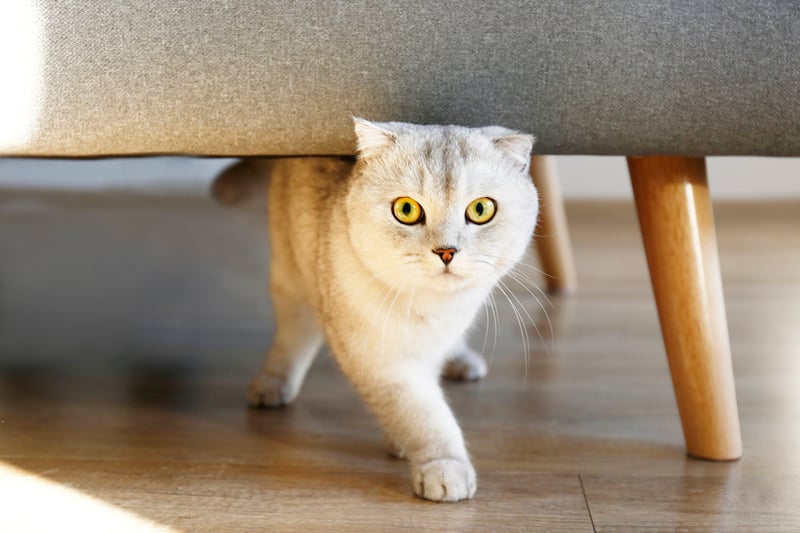
Your mind may be running rampant with all the possible reasons for your cat's limp. If your cat is not putting any weight on its leg, refuses to eat, or is becoming increasingly more lethargic—get to the vet now.
If your cat is limping but they don't seem to be in pain, remember that cats don't show signs of mild to moderate pain often.
Know that your veterinarian is there to help you in times like these. Don't hesitate to call and voice your concerns. Your vet will help you decide your next step.
If you have any questions about treatments and cat supplements for your cat’s limp, our friendly team is happy to provide support, and our blog has lots of helpful articles.
TRI-ACTA H.A. for Pets
Our maximum strength formula is optimally designed to accelerate the formation of cartilage, minimize inflammation, expedite the healing process, and improve joint conditions.

Newsletter Signup
Subscribe to our newsletter to receive the latest news and exclusive offers.
.jpg?height=2000&name=Cliick_Integricare-DISPLAY-REVISEDV2%20(1).jpg)
Proactive & Therapeutic Joint Supplements
When given daily, Integricare joint supplements recover bone and joint injuries faster and help prevent mobility injuries from happening in the first place.

